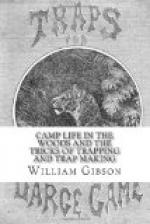every purpose. The upright props which support
the platform should be cut of thin wood. Let
one be an inch and a half long and half an inch wide,
the other being an inch in length. Each should
have one end whittled to a point, which will admit
of its being inserted in a gimlet hole in the bottom
of the trap. These gimlet holes should be made
at least half an inch in depth. Make the first
at about an inch or so from the back of the trap.
Into this insert the shorter pieces, broadside front.
Lay the pivot brad of the platform on the top of this
piece and insert over it a small wire staple, as seen
at (
a). Elevate the platform evenly and
determine the spot for the other gimlet hole, which
should be directly beneath the point of the filed
brad. Be sure that it is in the middle of the
board, so that the platform may set squarely, and be
perfectly parallel with the sides. Insert the
remaining prop in its place, and the platform is complete.
The overhanging spindle now requires a little attention.
This should be whittled off on each side, bringing
it to a point at the tip. On each side of the
spindle a long plug should then be driven into the
back piece, as our illustration shows. These
should be far enough apart to allow the spindle to
pass easily between them. The
setting of
the trap is plainly shown [Page 88] in our engraving.
The spindle being lowered between the plugs is caught
finely on the tip of the catch-piece. The blunt
point at the opposite end of the platform should have
a slight hollow made for it in the prop against which
it presses. If the platform be now strewn with
bait, the little machine is ready. It is certainly
very simple and will be found very effective.
THE BOX OWL TRAP.
The use of a box trap for the capture of an owl is
certainly an odd idea, but we nevertheless illustrate
a contrivance which has been successfully used for
that purpose.
The box in this case should be of the proportions
shown in our engraving, and well ventilated with holes,
as indicated. (This ventilation is, by-the-way, a
good feature to introduce in all traps.) Having
made or selected a suitable box—say, fourteen
or more inches wide, provided with a cover, working
on a hinge—proceed to fasten on the outside
of the lid a loop of stiff wire, bent in the shape
shown at (e). This may be fastened to the
cover by means of small staples, or even tacks, and
should project over the edge about two inches.
When this is done, the lid should be raised to the
angle shown in our illustration, and the spot where
the end of the wire loop touches the back of the box
should be marked and a slit cut through the wood at
this place, large enough for the angle of the loop
to pass through. Two elastics should now be fastened
to the inside of the box, being secured to the bottom
at the side, and the other to the edge of the cover,
as seen in the illustration. They should be sufficiently




